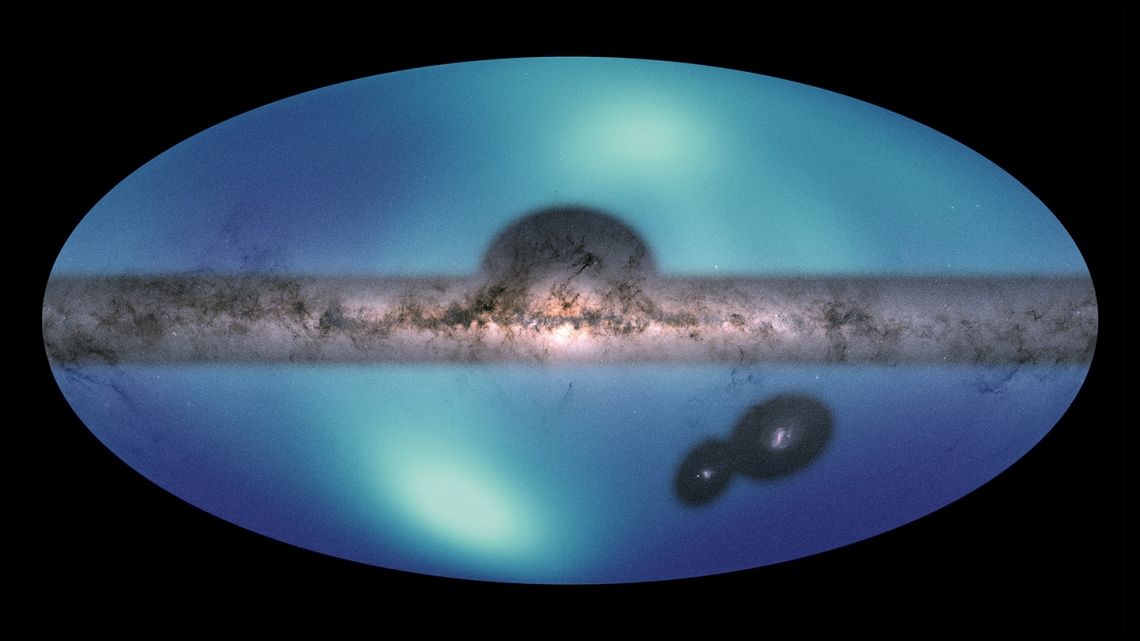Astronomers chart invisible ocean of dark matter swirling outside the Milky Way
The wake was revealed by a new map of the outermost region of our galaxy.

A mysterious wake of stars, stirred up by a small galaxy that is set to collide with the Milky Way, could be about to unlock the mysteries of dark matter.
The trail of stars, located outside the star-flecked spiral arms of the Milky Way's central disk in a region called the galactic halo, is being carried along in the cosmic slipstream of a dwarf galaxy in orbit around the Milky Way, according to a new sky map created by astronomers.
The galaxy, called the Large Magellanic Cloud (LMC), is orbiting some 130,000 light-years away from Earth and stirring up the wake of cosmic material behind it. At first glance, the LMC’s trail appears to consist solely of stars, but the researchers know that the stars are just along for the ride. They are suspended inside a far larger, completely invisible presence.
Related: Spaced out! 101 astronomy images that will blow your mind
Astronomers are interested in this ripple in space because they think it could be made up of dark matter — the mysterious non-luminous substance making up the vast majority of matter in the universe. Predictions say that dark matter, invisible and interacting with the matter we can see only through gravity, should be everywhere in the galactic halo.
"We think this wake is made up of dark matter, and it drags stars along with it, which is how we can detect it," study co-author Nicolás Garavito-Camargo, a University Arizona doctoral student, said in a statement.
Dark matter's gravitational influence can be observed throughout the universe: It is our galaxy's vital scaffolding, glueing stars and planets to it so they don't fly off as the galaxy spins. Yet, what exactly dark matter is, or how it behaves, remains one of astronomy's greatest mysteries. The researchers are hoping that by studying the wake, they will be able to study the dark matter they believe makes up the vast majority of it.
Get the world’s most fascinating discoveries delivered straight to your inbox.
If the wake's stars are like leaves floating on a dark matter pond, the way that the leaves are disturbed by a boat (in this case, the LMC) can tell us a lot about the pond itself.
"You can imagine that the wake behind a boat will be different if the boat is sailing through water or through honey," said lead author Charlie Conroy, a professor of astronomy at Harvard University. "In this case, the properties of the wake are determined by which dark matter theory we apply."
The group has used their new map and the position of the wake to confirm a theoretical model, created by another group of researchers, about just how dark matter should be distributed across the galactic halo; they are now running tests to see which of the theories about dark matter best fits the wake's shape and location.
The map, made with data from NASA and European Space Agency (ESA) telescopes, also provides some vital insights into our home galaxy's violent future. As the LMC orbits the Milky Way, the gravitational tug from the dark matter in the Milky Way’s galactic halo is slowing it down, sending the LMC into smaller and smaller orbits. The LMC will continue to be reeled closer to the Milky Way until, in about 2 billion years, the two will collide.
The merging of two galaxies is a surprisingly common event throughout the universe. The Milky Way likely merged with a small galaxy 8 billion years ago, and galaxy mergers are a key reason for the growth of all large galaxies.
"This robbing of a smaller galaxy's energy is not only why the LMC is merging with the Milky Way, but also why all galaxy mergers happen," study co-author Rohan Naidu, said a graduate student at Harvard University. "The wake in our map is a really neat confirmation that our basic picture for how galaxies merge is on point."
The researchers published their findings April 21 in the journal Nature.
Originally published on Live Science.

Ben Turner is a U.K. based writer and editor at Live Science. He covers physics and astronomy, tech and climate change. He graduated from University College London with a degree in particle physics before training as a journalist. When he's not writing, Ben enjoys reading literature, playing the guitar and embarrassing himself with chess.
 Live Science Plus
Live Science Plus





